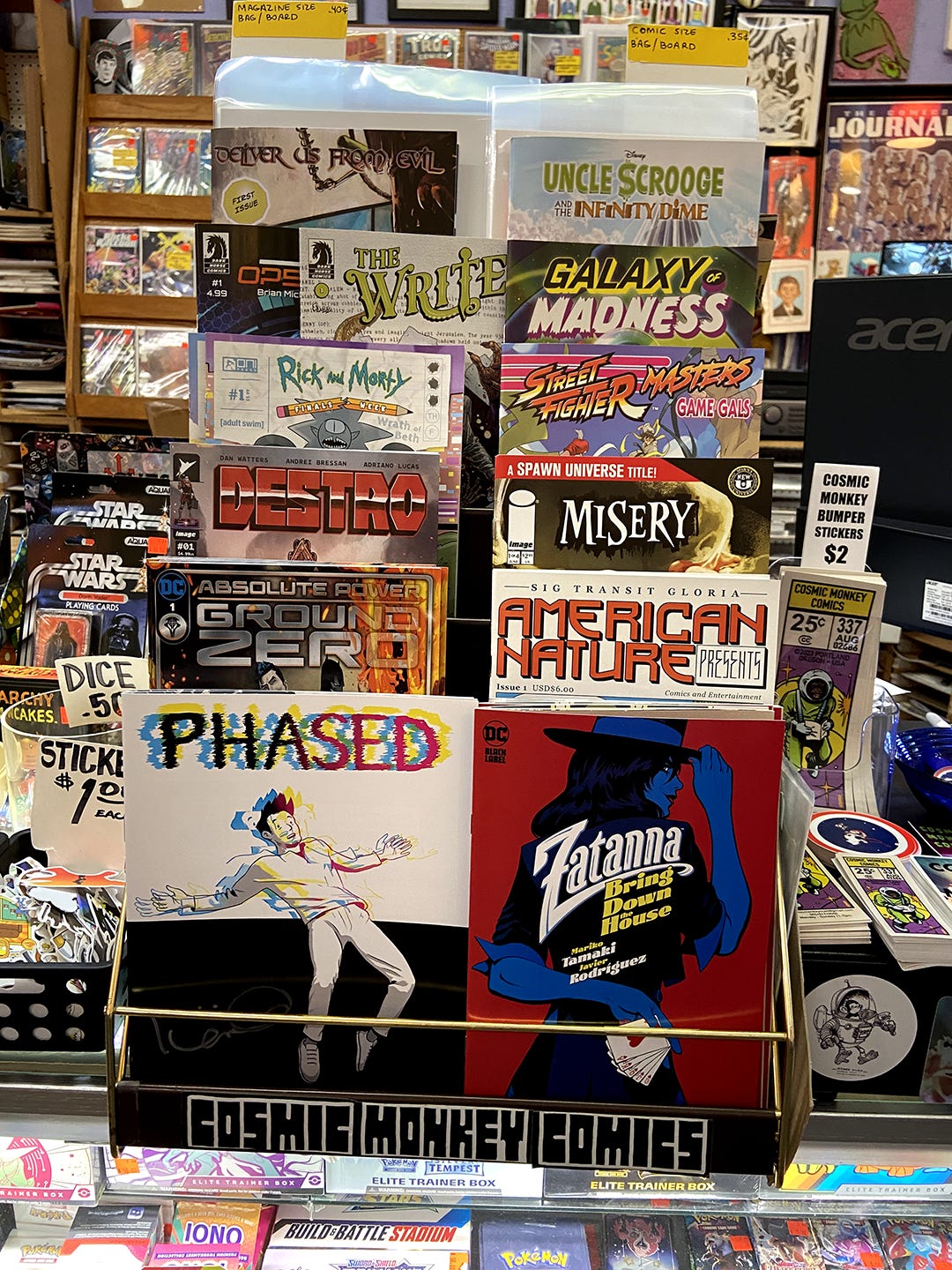Learning How to Get Your Books to Your Readers
The Business Side of Creating: Distribution Is a Bear
A quick update on Phased: it’s now in select comic shops in Portland, OR and one in Olympia, WA! If you’re in the area, check out:
Books With Pictures, Portland, OR
Cosmic Monkey Comics, Portland, OR
Floating World Comics, Portland, OR
Danger Room Comics, Olympia, WA
And this leads in to today’s discussion about the business side of creating, and in particular distribution.
Since finishing Phased, I’ve been learning a lot “on the job” about the business side of being an independent creator.
Printing
The eye-opening lessons here were about strategically designing the product so that you can price things to be reasonably attractive to customers while still bringing in enough revenue to meet your goals. While making Phased, I wasn’t worried about costs or making money since it was just a story I found compelling and wanted to share it with as many people as would find it interesting. That said, if you want to actually make a living as an independent creator, then profits matter a lot. And once I actually finished Phased and started getting it into stores, (1) suddenly I was learning about how those arrangements are structured, the cut that stores take from sales, and (2) I enjoyed making Phased so much and got such a positive response from people that me telling more stories became a thing.
Marketing
As an independent creator, getting the word out about your work and growing your audience is all on your shoulders (well, unless you’ve got the money to pay for other people to take it on for you). We’re in a very unsettled time for the marketing landscape, though. I’ve written before about how creators need to be good at promoting themselves now (and that I’m bad at it). Social media used to be a critical tool for getting new eyeballs on your works, but algorithm driven platforms these days are designed around virality, meaning that it can be difficult for even creators with established audiences to get the work in front of even their existing followers, and nigh impossible for newbies. This is why I’ve been focused on this Substack and am looking at festivals instead.
But today’s post is mainly about…
Distribution
It’s a freaking bear. And not something that I’d thought much about beforehand. You’ve created your creation, got it produced in some quantity, and are ready to get it out to the world. But how do you get it from your warehouse garage living room to stores where people, current fans and new potential readers and customers, can actually see it? Even if you already have a fan base that wants to buy your books (you could insert whatever physical product here), you still need to get it from wherever it’s produced to the places that people will buy it.
Distribution is so time intensive and costly to scale that it’s a whole business in itself, and that’s why there are companies that focus just on distribution of goods, whether it’s books, toys, food, cosmetics, etc. It’s simply not a great use of time as a creator to distribute your wares widely beyond your local area yourself. Let’s take a look: to do it yourself,
you need to establish a relationship with every single store that will agree to sell your goods, which takes time (this could involve showing up at stores in-person to have store reps evaluate your product(s), but depending on the store could be done remotely, too) and will involve rejections as well;
you need to drive to every single store to get your goods to them or else pay to ship to store (and prep and drive your goods to the shipping company);
in the case of small-time local artists selling on consignment, you need to periodically check back in with stores, often in-person, to check on the status of sales and collect payment;
you’ll need to keep repeating bullets two and three if your product sells and the stores are interested in continuing to stock it; and
on top of all of that stores take a hefty chunk of sales revenue, most commonly 40%-50% of the gross revenue. (Some stores will buy wholesale from creators, which is nice because it means the sale is guaranteed from the creator’s perspective and you get the revenue up front—which is why some stores do it; to be supportive of local artists.)
Put that all together and it means that you shouldn’t rely only on selling in stores to make money. Personally, I think it’s still worth doing to some extent for two reasons:
Local comic/bookstores need support, too, and all this activity helps to build and maintain community around these stores (and in the case of consignment, provides them with product on a low-risk basis that could convert to revenue for them and a little or some for you depending on your product’s margins).
If your product is on a store’s shelves, you have the potential for exposure to new readers. And some people like discovering and supporting local artists, too.
So what about paying someone else to distribute your goods?
As a creator, I’d rather be spending time creating more work to connect with readers than delivering goods (though, as an analytical person, I actually find the technical and strategic parts of the business interesting, too). The creative work is what your business is about, not distribution, which is a very different function that is not tied to your creative identity and can be outsourced.
The thing with paying a distributor to distribute, however, is that they’re going to take a significant slice of your gross sales, too. The benefit is that they can leverage their relationship with retailers and economize on the logistical costs by handling goods from many producers to greatly expand your geographic reach. It becomes much more advantageous the larger your audience and print runs and the lower your production costs. Distributors are another gatekeeper in a potential process, and like publishers, they come with pros and cons.
My Approach Right Now
So how am I balancing these considerations?
Well, as noted above, distributors are a gatekeeper, too: they can only handle so much product, and have their own brand and reputation to maintain, so they’ll tend to have guidelines on what they’re looking for (things like what kind of genres and authors, do they carry comics, prose, poetry, etc.).
Furthermore, there aren’t many distributors around; books are a tough business. The biggest distributor for small press just shut down this spring. (Not that independent authors were who they carried.)
So that means I’m not worrying about distributors right now. I’m taking things a step at a time and focusing on stores in my immediate locality while building direct relationships through this Substack and festivals. I stopped by those comic shops in Portland and Olympia because I was on the road and will probably try to do things incidentally that way as opportunities arise.
But ultimately, what I’ve learned about the practice of being a writer and artist this year as I’ve dived into both the creative and business sides of the pursuit, is that you really need to enjoy the process of the creative work and let the audience and business develop over time. It’s the lucky few who break out early on. The overwhelming majority of us will never be able to make a living as a writer.1 And as Gabrielle Zevin noted in a recent episode on Adam Grant’s podcast ReThinking, there are already so many (so. many.) books out there that if you were stuck in a Barnes & Noble, you’d have enough reading material to last you till the end of time.
So do it because you have stories you want to tell and ideas you want to share. Do it because you love creating.
The arts are not a way to make a living. They are a very human way of making life more bearable. Practicing an art, no matter how well or badly, is a way to make your soul grow, for heaven's sake.
Eric Hoel did this analysis to understand how rare it is for a writer to earn a living from their writing, modestly defined as earning a $250,000 advance once every five years—in other words just $50,000 per year on average (which would be difficult to live on in a high cost-of-living city). And per his analysis, there are roughly as few writers able to make a living off their writing as there are billionaires in the country. Keep the day job! Or, you know, have a rich benefactor or supportive spouse.






